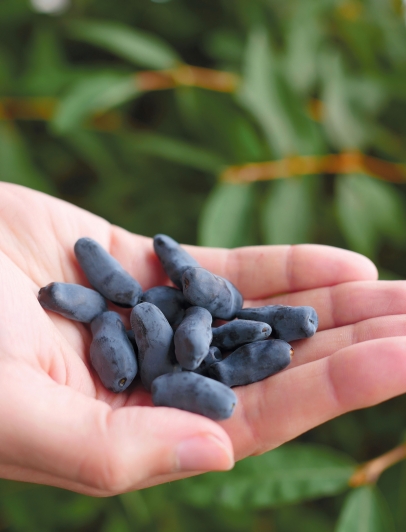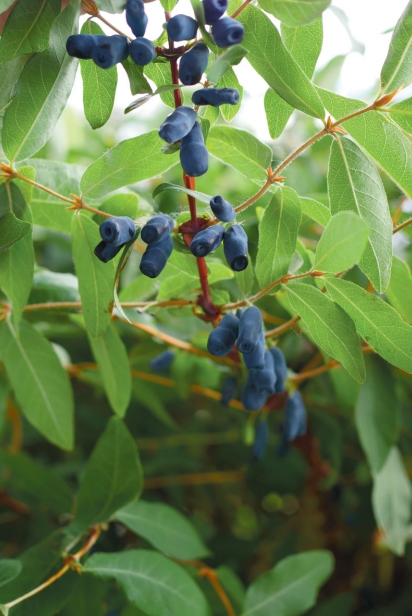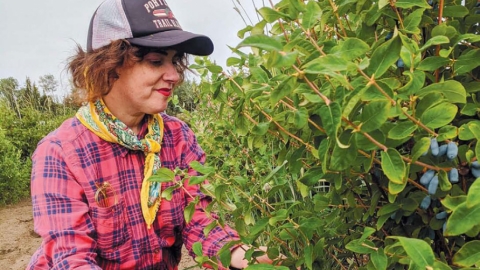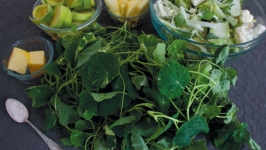Haskaps or Honeyberryes: Bountiful Berries Flourish in the Last Frontier
While Alaska’s climate isn’t exactly suited for most perennial fruits, there’s no debate that we can grow world class berries like nobody’s business. Haskaps (sometimes called honeyberries because of how sweet many varieties taste) are certainly no exception.
If you’ve never seen a haskap before, you might just mistake them for oddly-shaped blueberries. Haskap berries have an almost dusty-looking matte finish and thin skin, similar to a blueberry. They are bursting with flavors that range from slightly tart to quite sweet, depending on the type. The berries are oblong and grow in loose clusters, repeating all the way down the arm of main bush branches. The volume of berries that a single, mature haskap bush can produce is impressive, to say the least. Like wild Alaska blueberries and cranberries, haskaps are rich with antioxidants, substances that help our bodies fight disease and maintain good health.
Unlike raspberries and watermelon berries, haskaps have small seeds that are hardly noticeable. They’re great for making syrups, jams and wines, tossing into salads, or just eating raw handfuls straight from the bush. While it doesn’t scare off avid berry lovers, just be warned — overindulge while picking (which is easy to do!) and they’ll stain your hands and mouth a beautiful shade of dark bluish-purple.
Haskaps are a member of the honeysuckle family, which makes sense when you look at their flowers. The early bloomers, which are a honeybee favorite, definitely look like tiny honeysuckles. The bushes themselves make ideal landscaping hedges because of how fast and full they grow. Based on the variety and care, they can grow anywhere from 2 - 6 feet tall or more.
Haskaps have been professionally bred and cultivated over the years by horticulturalists (primarily in Russia, Japan, and Canada) into the many commercial varieties that we have today. Some of the most popular are Tundra, Borealis, Indigo Treat, Aurora, and Polar Jewel, but there are plenty more. Many local nurseries around the state sell haskaps throughout the spring and summer planting season.
Over the years, haskaps have been rising in popularity and name recognition because of how well they’ve been bred to thrive in relatively cool temperatures, and how easy they are to take care of. Haskaps are extremely cold-hardy and tolerant perennial plants, perfect for growing conditions around the state.
Pat Holloway, a retired University of Alaska Fairbanks horticulturist, spent years at the Agricultural Experiment Station in Fairbanks growing and studying haskaps. Holloway says that UAF has had trials with a lot of varieties over the years, and nearly all of them grow well across Alaska.
“They all bloom mid-May through mid-June in Fairbanks. Because of this earliness, they attract a bazillion bumble bees and other pollinators, because there is little else blooming at that time in gardens,” remarks Holloway. “They are the first berry to ripen in gardens, often taking people off guard because you’ve just finished planting your veggies, and the fruit is ready to pick!”
In your own garden, Holloway says a good way to discover when your haskap berries are ripe is when you start noticing abnormal numbers of birds surrounding your plants. “I usually find out I have ripe fruit because my bushes are mobbed by robins. They devour the large fruit and will clean out the bushes if you don’t protect your plants with bird netting.”
Even though they grow well here, it’s surprising how many people still have never heard of haskaps or can’t identify them. “About 10-15 years ago, the Master Gardeners of the Tanana Valley decided to make a collective purchase of these honeyberries/haskaps, and many of the members planted them for trials. They were an overwhelming success and can produce gallons of fruit on just a few bushes,” says Holloway.
According to Holloway, the definitive success of the trials began to create more of a local familiarity with haskaps, building a demand and stimulating more people to plant them. Now, years later, haskap bushes can be found flourishing all over the Tanana Valley.
Haskaps grow well throughout Anchorage’s micro-climates, too. I’ve noticed them used as inconspicuous edible landscaping around town, and I’ve seen them nearly explode in personal gardens, quickly increasing in size from season to season.
If you’re contemplating planting haskap bushes in your yard this spring, it’s important to keep in mind that they do require cross-pollination from a different variety, so you’ll want to choose a few kinds of haskaps if you want to enjoy a delicious, annual early summer berry harvest.
With healthy antioxidants, incredible flavor raw or cooked, and the ability to thrive in a cold environment, there’s certainly a lot to love about haskaps. Consider adding them to your yard this year — the honeybee, birds, and your neighbors will thank you.
First published in the Spring 2018 issue of Edible Alaska.










